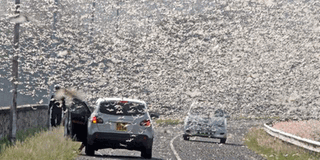Premium
Ravenous locusts threaten country’s economy, farmers’ income

Motorists encounter a swarm of locusts at Kamburu Dam in Embu County. PHOTO | JOSEPH KANYI | NATION MEDIA GROUP
What you need to know:
Government terms speed of invasion ‘unbelievable’, says it’s struggling due to pesticide shortage.
FAO warns weather conditions are favouring the pests’ reproduction.
Central Bank Governor Patrick Njoroge has warned that if the invasion is not dealt with quickly, it could ruin the economy.
Peter Irungu, a dairy farmer at Kamuiru in Murang’a county, woke up on Thursday to find his three-acre farm painted red. On closer look, he realised with horror that a swarm of the dreaded desert locusts was devouring his napier grass.
DEVASTED FARMS
Also under attack were mangoes, which supplement his dairy earnings. A distress call brought neighbours who helped chase the pests with stones and sticks.
But these rudimentary weapons are no match for the voracious armies that have so far devastated farms and pastureland in 14 counties in northern and central Kenya.
“A sack of fodder for livestock, like the napier grass, can go for up to Sh200. With this invasion I’m finished,” Mr Irungu said.
Mr Irungu is not alone. Residents of Kamuiru, Mirira, Gikuu, Gitungano and Muthigiriri villages of Kiharu Constituency are staring at complete loss of their crops after the swarms arrived from neighbouring Machakos. Farmers fear that the locusts may have left eggs in their farms.
But Murang’a County Agriculture Executive Albert Mwaniki said the locusts are not yet at that dangerous stage. He said that after spraying the Masinga area of Machakos, some locusts may have flown and regrouped in Murang’a, adding, the county government has enough chemicals to control the pests.
HEAVY LOSSES
In Embu, locusts have destroyed 747.5 acres of crops and green pastures, according to Mbeere South Sub-county Agricultural officer Paul Kiige. Most affected are Kiambere, Mavuria, Mariari, Soiri and Rurii areas, where 500 acres of pasture and 125 acres of cowpeas have been ravaged.
Further, 62.5 acres of green grass and 60 acres of sorghum have been destroyed in the arid Mbeere. Muguka, a popular stimulant in the region, has also been affected. Mr John Runji, a resident, narrated how locusts invaded his farm and destroyed, five acres of muguka, maize, green grams and pawpaws.
The locusts have destroyed some 13,000 square kilometres of pasture in Isiolo and Marsabit counties. In Samburu, special programmes chief officer Daniel Leisagor said at least 70,000 acres of pastures have been destroyed in the county, which is fighting 14 swarms with fresh invasions reported.
Mr Adan Giro, a farmer in Kinna village of Garbatulla, Isiolo, has suffered heavy losses from what is now perceived as a climate change phenomenon.
FOOD SECURITY
“Half my field of kunde (cowpea leaves), and the leaves on half my maize plantation were wiped clean. Thank God the maize was mature,” said Mr Giro, who had dedicated at least 20 acres to the two crops.
Government yesterday owned that it was facing challenges handling the menace. It described the speed of the invasion as “unbelievable.”
Agriculture PS Hamadi Boga told the Nation that shortage of effective chemicals was hampering progress, but added, a consignment was expected from Japan last night.
“Local companies don’t keep large stocks. We managed to get 1,275 litres of fenitrothin from Tanzania. We’re expecting another 10,000 litres from Japan,” the PS said.
The official spoke even as the Food and Agriculture Organisation (FAO) of the United Nations said more than Sh7 billion is needed to control the pests in the Horn of Africa where the food security of 32 million people is at risk. Already, 11.9 million people are experiencing severe food insecurity in Kenya, Ethiopia and Somalia. FAO said a further Sh600 million is urgently needed to save the situation in Djibouti and Eritrea where there’s an upsurge in locust activity.
LONG-TERM PLAN
About 485,000 hectares are targeted for control in Kenya, Ethiopia and Somalia. In Eritrea and Djibouti, 40,000 hectares are targeted.
Speaking during a briefing of representatives of affected states in Rome, FAO Assistant Director-General for Agriculture and Consumer Protection Bukar Tijani said the efforts are aimed at reducing the impact on food security as “we cannot eradicate locusts.”
FAO Deputy Director-General for Climate and Natural Resources Maria Semedo said Agriculture ministers from the Horn of Africa will meet in Addis Ababa next week to address the crisis.
“We need to act immediately. There is need for a long-term plan on how to deal with the problem. Regional and subregional organisations, and local governments should work closely on this. Real-time information on the desert locusts is needed,” she said.
FAO said the favourable weather conditions in the region will allow breeding until June. “This could lead to 500 times more locusts,” FAO stated.
HIGHER INFLATION
“Desert locusts could reach key production areas and cause significant crop losses in 2020. This would have the potential to result in below-average national harvests, exacerbating the already serious food security situation,” the UN food agency warned.
Meanwhile, the government has denied claims that insecticides used in aerial spraying of locusts are ineffective, saying, the chemicals take time to work.
Government Spokesman Cyrus Oguna said that the government is using two kinds of chemicals, one that kills locusts instantly and another that kicks in two to three days after spraying.
On a positive note, Laikipia County Agriculture Executive Lucy Murugi said the county had managed to control the insects.
Central Bank Governor Patrick Njoroge has warned that if the invasion is not dealt with quickly, it could ruin the economy. He said investors will shy away if it appears “we don’t know what we’re doing.” Treasury CS Ukur Yatani also warned of higher inflation.
Reports by David Muchui, Pauline Kairu, Waweru Wairimu, George Munene, Ndung’u Gachane, Geoffrey Ondieki, Steve Njuguna and Nicholas Komu.




